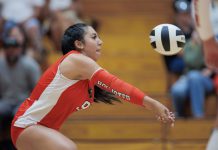Hit the turf for solid contact
By Don Leone
When giving a lesson, there are several things I observe.
One important detail I’m looking for is how the student makes
contact with the turf. If I see the student is not hitting the
ground at all, this tells me their trying to scoop the ball off the
turf
— not good if you’re trying to get it airborne.
Hit the turf for solid contact
By Don Leone
When giving a lesson, there are several things I observe.
One important detail I’m looking for is how the student makes contact with the turf. If I see the student is not hitting the ground at all, this tells me their trying to scoop the ball off the turf — not good if you’re trying to get it airborne.
Hitting too much turf could be a problem also, so what should be the perfect divot? The ideal impact should be making contact with the ball and a thin layer of the turf. A tour professional’s career would be short-lived if they were digging too much turf.
Identifying what’s happening at impact can help you determine whether you’re making the correct swing. For instance, if you’re taking too much turf or hitting behind the ball, chances are the angle the shaft or plane is coming into impact is too steep. Conversely, if you’re not hitting the ground at all, you may be too shallow coming into impact.
Next time you’re on the practice tee, check the divot pattern. Notice the depth and direction of the divot relative to the target line. If it’s deep and cutting across the target line, you need to shallow out the path of the swing until you’re making a thin shallow divot. If you’re not hitting the turf at all, swing the club on a more vertical path until you’re making the correct contact with the turf.
You’ll find a thin divot after contact will produce a solid penetrating ball flight.









